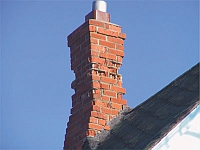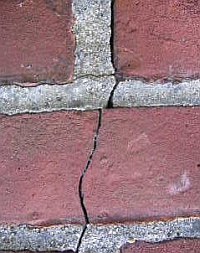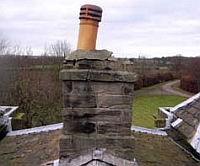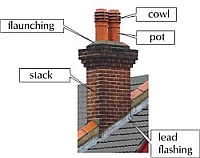
Chimney Repair
A properly functioning chimney has enough draft to pull smoke out of your home and provide enough oxygen for hot, complete burning of wood to occur.
It is important that your chimney is the right type and style for your firebox or stove. In addition, it should be installed properly in your home in compliance with building codes and manufacturer instructions.
A well-designed system has the following performance characteristics:
- fires light easily and burn bright and hot
- draft builds quickly
- Specialist Carpentry Services
- lighting fires does not cause smoke to fill room
- opening the door does not cause smoke to spill out
- when fire is not in use, air flows into the stove and cold air and bad smells do not come out
Common Repairs
The purpose of your chimney is two-fold. It must remove harmful byproducts created when fuel is burned, and it must carry excessive heat away from combustible items near the fire.
Besides being cleaned and inspected each year, your chimney will also need occasional repairs to ensure that it is performing these functions properly. Repairwork can be done by masons or fireplace professionals.
- Firebox repointing and rebuilding—the firebox is the brick area where you build your fire; loose bricks and degraded mortar should be repaired
- Mortar crown repair—the mortar crown is the concrete like surface at the top of your chimney that keeps water out of your flue; a cracked or broken mortar crown should be repaired immediately to avoid serious water damage
- Damper repair—A damper closes the flue when you aren’t using the fireplace so heat doesn’t escape through the chimney
- Flue repair —the flu is the internal part of the chimney that funnels exhaust from your fireplace to the outside; if it cracks, breaks, or is blocked by debris or creosote build up it is a safety hazard that needs to be repaired.
A note on carbon monoxide A chimney functions to remove the byproducts of burning fuel. Carbon monoxide is one of these byproducts. It is a colorless, odorless gas that is a serious health hazard. It causes illness and death if it is inhaled in large amounts.
For the safety of your family and guests is critical to that your chimney is maintained properly so that carbon monoxide and other harmful fuel byproducts do not enter your home. Annual inspections are important. Also, you should have carbon monoxide detectors installed on each floor of your home, as well as in sleeping areas.
Carbon monoxide detectors can let you know if there are possible problems with the venting systems of your furnace, gas hot water heater, or gas stove and will keep you from being harmed from prolonged exposure to low levels of carbon monoxide.
Other safety tips : -
- Do not bank fires or close dampers to prolong burning
- Burn properly aged wood, not green wood
- Burn fires hot to minimize creosote buildup
- Regularly check the outside parts of your chimney and any connection points for any visible damage
- Have your chimney annually inspected by a professional for any structural damage, and cleaned as needed

Common Problems
Leaning Chimneys
A combination of erosion, acid attack and salt crystallisation are liable to cause a chimney to lean. The Good Repair Guide says any chimney that leans more than 1mm in 100mm is unsafe. This is perhaps a little too cautious and where historic buildings are concerned, one may wish to apply the middle third rule to the shaft wall around the flue. Thus where the shaft wall is half a brick thick, a lean of 35mm could be tolerated, but if in any doubt, consult a structural engineer.
Where repairs are impossible, the remedy of last resort is to rebuild the stack from some convenient point - say the top section only or completely from below roof level - using as much salvaged material as possible.
To comply with The Building Regulations any rebuilt section will have to have an internal diameter of 200mm (although 185mm is acceptable for a relined flue), so some ingenuity may be required to incorporate a flue liner within the original stack dimensions. If it is decided that the existing lean on a stack can be tolerated the factors inducing the lean should be stabilised. The flue should be lined (see Parging Failure below, and broken or decayed bricks should be cut out and replaced.
In slender stacks it is a wise precaution not to take out too many bricks at a time (sometimes no more than one at a time) and the new mortar must be allowed sufficient time to achieve strength before proceeding with the next area of cutting out. Cracks should be repointed and all 'defective' mortar raked out and repointed. 'Defective' mortar may be taken to include that which is loose, crumbling or cracked. As a general principle (and this applies to all repointing, not just on chimneys) if a lime mortar is difficult to remove, repointing is not necessary. Any hard cement mortar will be more difficult to remove. Take care not to damage the edges of the brick or stone. Rake out to a depth of 25mm or twice the width of the joint whichever is the greater; do not rake out deeper than 35mm.
The strength and lime content of the mortar will depend on the hardness of the brick or stone, in accordance with usual good practice for repointing. If it is necessary to add some cement to the mix, use sulphate-resisting cement. Similar mixes will be used for rebuilding stacks. Once a leaning stack has been stabilised, some periodic checking is advisable.

Vertical Cracks
Thermal expansion of the flue lining can cause vertical cracks to appear in the structure of the chimney, particularly where the flue is hidden within the thickness of a wall and where its actual presence has in any case introduced a point of weakness.
Where this is the most likely cause of failure (and not settlement for example), the usual remedy is to install a flue liner (see Parging Failure below) which will provide some thermal insulation for the wall structure. Then point-up and make good the crack.
Demolished Chimney Breast
In houses and flats which have been poorly converted it is often discovered that the chimney-breasts have been removed in habitable rooms to create more living space, without removing the stack above.
This is a classic error, committed either through laziness or for the more laudable reason of wanting to retain the original roofscape. In either case, if the remaining stack has not been properly secured both it and the walls below it will be unstable. Chimney breasts and fireplaces in particular form a focus for the architecture of the interior and ought to be rebuilt. If, however, the owners object, the simplest solution is usually to introduce supporting beams bearing onto suitable walls or brackets to take the load of the stack lower down the wall.

Defective Pots and Flaunching
Chimney pots are held in place by a great glob of cement-rich mortar, the flaunching, which also acts as the weathering for the top of the stack.
The flaunching decays more readily than the pots, usually by frost action. It is a simple matter to replace the flaunching but take care not to damage the pots when trying to clean off the previous hard cement mortar flaunching. The only practical solution for broken chimney pots is facsimile replacements.
A wide range of designs is available from manufacturers and specials can be made to order to match originals. (Original chimney pots are often to be seen on abandoned and little-used flues.) Architectural salvage yards may also provide a useful source of replacements.

Chimney Maintenance
Annual maintenance ensures chimney safety
Safety guidelines call for annual professional inspections of all wood and coal stoves, fireplaces, chimneys, chimney connectors, and all other solid-fueled heating equipment.Follow up cleaning should be done according to inspection results.
Why chimneys get dirty
Creosote and soot are natural by-products of burning fuel, deposited on the inside of your chimney or flue pipe as a solid sticky, black layer that is highly flammable. This needs to be regularly cleaned from your chimney or flue pipe. To reduce build up and use fuel efficiently, keep your fires hot, and provide them with plenty of oxygen.
Damping fires to keep them burning longer produces more smoke and solid by-products. On average, your chimney needs to be cleaned after every two cords of wood that are burned.
How the chimney is cleaned
Brushes are used to remove creosote and soot from the firebox, smoke shelf, elbows, and connector pipes. This is done from both outside and inside the house.Occasionally there is creosote buildup that cannot be removed by brushing.
Professional chimney sweeps use chemicals to alter the composition of the hardened creosote and turn it into a powdery substance that can be easily removed.
Chemical vs mechanical cleaning
Chemical chimney cleaning products are available for use by homeowners. The Chimney Safety Institute of America (CSIA) cautions against using these products to replace professional, mechanical cleaning of the chimney. Homeowners should be aware that these products can loosen debris that can fall into hard to reach places in the chimney structure and cause malfunctioning of the chimney.
In addition, professional inspection is important because it often reveals hidden problems with the structure of a chimney that would otherwise go unnoticed, and could be potentially hazardous.

Glossary
Confused by the various terms used, take a look at the diagram above
Work Guarantee
All work undertaken by C. Stevens Roofing is covered by clear, written guarantees including workmanship and material, to give you added confidence. Our guarantee is backed by a long established reputation in the business and is respected and valued by works professionals throughout the county.
Insurance Guarantee

HomePro Insurance Backed Guarantees helping you to protect your investment. Although home improvement is one of the safest forms of financial investment, there is one pitfall that can be overlooked.
Most contractors issue a guarantee for the work they have undertaken, we are no different. However, thousands of contractors cease to trade each year.
If your chosen contractor ceased to trade HomePro will match the terms of the contractors original guarantee.





